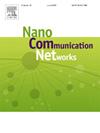High-gain radiating sun-shaped silicon-based wideband with defected ground structured dual-port MIMO antenna operating at 3.6 THz for 6 G Terahertz Applications
IF 4.7
4区 计算机科学
Q2 ENGINEERING, ELECTRICAL & ELECTRONIC
引用次数: 0
Abstract
In this work, we present a novel wideband 2 × 2 terahertz (THz) antenna array for MIMO applications, featuring a compact footprint of 300 × 490 × 50 µm³ on a silicon substrate with a dielectric constant of 11.9. The proposed design incorporates circular split-ring resonators (CSRRs) and radiating slots etched in a unique "sun-shaped" radiating layer, achieving broad bandwidth and efficient radiation characteristics. The two MIMO elements are positioned side-by-side to optimize data transmission and isolation. The antenna demonstrates a wide operational bandwidth from 1.76 THz to 5.07 THz, with a gain exceeding 9 dBi across this range. Key performance metrics include an envelope correlation coefficient (ECC) of -0.08 dB and a diversity gain of 9.92 dB at 3.16 THz, indicating strong MIMO performance and minimal mutual coupling. The reflection (S11) and transmission (S21) parameters are better than -40 dB, further confirming excellent impedance matching and inter-element isolation. Additionally, the channel capacity loss remains under 0.4 bps/Hz, ensuring efficient data throughput. The proposed sun-shaped MIMO THz antenna offers promising potential for high-speed, reliable wireless communication applications in the terahertz domain.
高增益辐射太阳形硅基宽带,具有缺陷地结构双端口MIMO天线,工作在3.6太赫兹,用于6g太赫兹应用
在这项工作中,我们提出了一种用于MIMO应用的新型宽带2 × 2太赫兹(THz)天线阵列,其在介电常数为11.9的硅衬底上的占地面积为300 × 490 × 50 μ m³。该设计采用圆形分环谐振器(csrr)和独特的“太阳形”辐射层中蚀刻的辐射槽,实现了宽带宽和高效辐射特性。两个MIMO元件并排放置,以优化数据传输和隔离。该天线具有从1.76太赫兹到5.07太赫兹的宽工作带宽,在此范围内增益超过9 dBi。关键性能指标包括-0.08 dB的包络相关系数(ECC)和3.16 THz时9.92 dB的分集增益,表明了强大的MIMO性能和最小的相互耦合。反射(S11)和传输(S21)参数优于-40 dB,进一步证实了良好的阻抗匹配和元件间隔离。此外,信道容量损失保持在0.4 bps/Hz以下,保证了高效的数据吞吐量。所提出的太阳形MIMO太赫兹天线为太赫兹领域的高速、可靠的无线通信应用提供了广阔的潜力。
本文章由计算机程序翻译,如有差异,请以英文原文为准。
求助全文
约1分钟内获得全文
求助全文
来源期刊

Nano Communication Networks
Mathematics-Applied Mathematics
CiteScore
6.00
自引率
6.90%
发文量
14
期刊介绍:
The Nano Communication Networks Journal is an international, archival and multi-disciplinary journal providing a publication vehicle for complete coverage of all topics of interest to those involved in all aspects of nanoscale communication and networking. Theoretical research contributions presenting new techniques, concepts or analyses; applied contributions reporting on experiences and experiments; and tutorial and survey manuscripts are published.
Nano Communication Networks is a part of the COMNET (Computer Networks) family of journals within Elsevier. The family of journals covers all aspects of networking except nanonetworking, which is the scope of this journal.
 求助内容:
求助内容: 应助结果提醒方式:
应助结果提醒方式:


